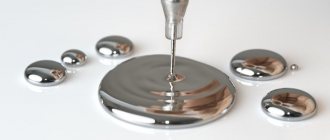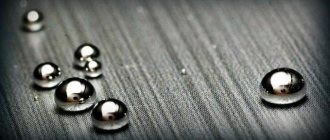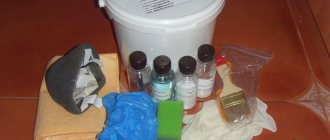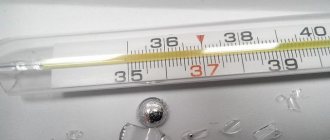What consequences are possible if the thermometer is damaged?
Mercury belongs to the first toxicity class poisons. This means that once the substance enters the body, the dangerous consequences are irreversible.
Mercury itself is practically not dangerous, but since it is the only metal that remains in liquid form under room conditions, its vapors and inorganic compounds (sublimate, calomel, mercuric cyanide) are dangerous. It evaporates at a temperature of +18 degrees, and the rate of its evaporation is 10,000 times less than the rate of evaporation of water.
A regular thermometer contains 1–2 grams of mercury. This is enough to poison all family members in the room where the thermometer broke. The danger also lies in the fact that the small balls are very mobile. They can scatter on the floor and roll into hard-to-reach places, from where they will evaporate for ten years, poisoning everyone around.
Please note that mercury can accumulate in the body. This means that if a substance sufficient to cause poisoning is ingested, symptoms may not appear immediately.
What is mercury poisoning
Symptoms of chronic poisoning appear several years after the body comes into contact with mercury, so it is better not to let this happen and strictly follow all the instructions in this article.
Evaporating, mercury poisons the air indoors and, if you regularly breathe this poisoned air, mercury will begin to accumulate in the human body, namely in the kidneys, liver and brain, after which chronic mercury intoxication
.
Such intoxication can be manifested by symptoms such as dermatitis, stomatitis, salivation, metallic taste in the mouth, diarrhea, headaches and dejection. In addition, mercury intoxication leads to kidney damage
, as well as trembling in the arms, legs and whole body.
It is worth noting that mercury, or more precisely its vapors, primarily affects the nervous system!
Poisoning can occur without any symptoms for a long time
.
The first thing that may occur to someone who has been poisoned by mercury vapor is irritability, accompanied by nausea
.
A person may think that his condition is due to fatigue at work or other similar reasons. But at this time the poisoning quietly creeps up to your central nervous system and kidneys
.
Mercury poisoning can occur, and symptoms of chronic poisoning may occur after several months.
, and even in some cases years. This applies to rooms where the air is poisoned by mercury vapor that does not greatly exceed the norm.
In what cases should you call specialists?
The Ministry of Emergency Situations on its official website gives detailed recommendations for the collection of mercury in residential premises. Immediately after the thermometer has broken, it is better to call the rescue service at 101 or 112 and consult with a representative of the Ministry of Emergency Situations on this issue.
Unfortunately, in Russia there is no well-functioning system for organizing the collection and disposal of mercury. In some cases, representatives of the SES and the Ministry of Emergency Situations do not even go to the scene of the incident, and give recommendations for collecting mercury over the phone. If employees refuse to respond to a call, contact a higher authority and ask for help. If you do not get a team to come out, collect the mercury yourself and take it to a radioactive waste collection point.
In megacities, there are often private companies that collect and dispose of the remains of broken thermometers and mercury. They also check the air for fumes. However, since these firms are private, you will have to pay to call a specialist.
Priority measures after demercurization
After the service has carried out the necessary measures to clean the premises, the consequences of contamination by toxic compounds can be felt for quite a long time. After removing hazardous substances, the room should be ventilated and wet cleaned daily for 2-3 weeks (chlorine-containing products are used for this). Those who independently collected mercury compounds and were in the building should especially carefully monitor their well-being.
Even in the absence of pronounced symptoms of intoxication, doctors advise:
- Regularly rinse your mouth with a solution of potassium permanganate for at least 2-3 days.
- Introduce milk, rice, and oatmeal into your diet.
- Use laxatives.
In some cases, experts recommend taking activated carbon and gastric lavage. These measures should be used with caution and are not suitable for all intoxication management options.
What should not be done if a thermometer breaks in the room?
In order not to aggravate the problem, and not to scatter mercury around the room even more, under no circumstances:
- Do not touch mercury with bare hands.
- Don't sweep up the mercury. The broom will break it into smaller particles and scatter it around the room even more.
- Don't vacuum. When using a vacuum cleaner, warm air is released, which promotes the rapid evaporation of the substance.
- Do not use a magnet. Not only will it not collect the balls of the substance, but it will also scatter them around the room even more.
- Don't wash the floor. A damp or dry cloth will only rub the mercury over the surface being treated.
- Do not throw the collected thermometer fragments and mercury into the garbage disposal, as it will continue to evaporate there.
- Do not flush the substance down the toilet or sink, as the mercury will settle on the pipes and continue to evaporate.
- Do not create drafts in the room, otherwise mercury vapor will spread over a large area.
- Do not bury or burn the substance, causing irreversible consequences for the environment.
- Do not wash items that have been exposed to mercury, but rather recycle them.
- Do not turn on the air conditioner, otherwise mercury vapor will settle on its filter.
Be sure to read the guidelines for disposing of mercury at home.
Pros of a mercury thermometer
- it more accurately measures the temperature of the human body, and its readings can be compared with those of a gas thermometer, which is considered a reference thermometer.
- such a thermometer is less susceptible to extraneous factors and temperature fluctuations than its “colleagues”.
— by placing a mercury thermometer in a disinfectant solution, you can quickly disinfect it, which cannot be said about other types of thermometers.
- this thermometer is inexpensive when compared with electronic versions, and at the same time it is quite difficult to manufacture, because it requires mercury of special purification and fairly high quality. This fact gradually leads to the fact that there are fewer mercury thermometers, and more electronic ones, and with constant progress in the field of high technology, electronic thermometers will fall in price and become more attractive to buyers.
- A mercury thermometer is very easy to use.
How to collect mercury at home
The main thing is to carry out all the actions correctly and without panic, and first of all call the Ministry of Emergency Situations.
Clearing the premises from strangers
First of all, isolate all people and pets from the premises. Close the door to the room to prevent evaporation from spreading throughout the apartment.
Airing the room
To reduce the room temperature, open a window for ventilation. Also remember to turn off all heating devices if they are on. Your task is to reduce the air temperature so that the mercury does not evaporate.
Be extremely careful not to allow a draft to form in the room, otherwise air vapor will spread the toxic substance throughout the apartment.
How to collect mercury
When all household members have been removed from the apartment, the room is closed, and the windows are open, begin collecting mercury. First of all, prepare the necessary tools and substances. You will need:
- unnecessary clothes that you won’t mind throwing away later;
- latex gloves;
- shoe covers;
- respirator or cotton-gauze bandage;
- safety glasses (if available);
- medical syringe;
- brush;
- paper;
- plaster or tape;
- container with a tight lid for collecting toxic substances;
- flashlight.
Also prepare the demercurization solution in the required quantity in advance.
Procedure:
- Change into old clothes, put gloves on your hands, put a bandage on your face, and shoe covers on your feet.
- Prepare a demercurization solution and pour the required amount into the container.
- Using a wet brush, collect the largest balls onto the paper.
- Aspirate the middle particles of the substance with a syringe.
- Collect the smallest ones with tape.
- Using a syringe needle, remove mercury particles from hard-to-reach places.
- Turn off the lights or close the curtains and shine a flashlight across the floor to spot any remaining glare.
- Place the collected mercury and fragments of the thermometer into a container with the solution and close the lid tightly.
You definitely need to look at the area where the thermometer broke, again using a flashlight.
After this, start cleaning the room. Subsequently transfer the collected mercury to the collection point.
Demercurization
Demercurization is the process of removing mercury using physical methods or chemicals, disinfecting the premises to prevent poisoning of family members. For demercurization, a special solution is prepared, into which the remains of the thermometer are placed and the contaminated surface is treated.
Potassium permanganate solution (potassium permanganate)
For temporary storage and disposal of mercury, use a strong solution of potassium permanganate.
When diluting the substance, focus on the color of the mixture, which should be deep purple. You can use both hot and cold water. Also add salt and vinegar to the liquid at the rate of 1 tbsp. spoon per 2 liters of prepared solution.
Fill a three-liter jar with potassium permanganate solution more than halfway, and place the collected mercury in it. Treat all surfaces that came into contact with the substance with the remaining liquid.
Please note that potassium permanganate can turn things pink, so proceed very carefully.
Be sure to place the broken thermometer and all its elements in a jar of solution, first wearing gloves.
Bleach solution
Both dry lime and liquid bleach, for example “Belizna,” are suitable. Mix 0.5 liters of the substance with 2.5 liters of water. Treat all surfaces in the contaminated room with the prepared solution. After 15 minutes, rinse off the substance with clean water. Repeat the procedure three times to ensure results. When doing this, make sure the room is well ventilated.
Soap and soda solution
This product can be used either independently or in combination with other demercurization methods. Dilute 100 g of soap and 100 g of soda in two liters of warm water. Make sure that the substances are completely dissolved and only then begin processing.
How to finally clean the room?
After collecting mercury, thoroughly treat all surfaces and objects in contact with it with a demercurization solution. For the best effect, use all substances in combination. First, wash all surfaces with a bleach solution, repeating the procedure three times. After drying, treat all items again with a solution of potassium permanganate.
After final cleaning of the room, remove clothing and protective items and pack them in a plastic bag. Rinse your mouth several times with soda solution and wash your body thoroughly. Take an activated charcoal tablet and drink plenty of fluids. Every day for a week, while the room is closed from visitors, treat it with a bleach solution.
Service cost
Promotions and discounts
#tab_container_2861 { overflow:hidden; display:block; width:100%; border:0px solid #ddd; margin-bottom:30px; } #tab_container_2861 .tab-content{ padding:20px; border: 1px solid #e6e6e6 !important; margin-top: 0px; background-color:#ffffff !important; color: #000000 !important; font-size:15px !important; font-family: Helvetica !important; border: 1px solid #e6e6e6 !important; } #tab_container_2861 .wpsm_nav-tabs { border-bottom: 0px solid #ddd; } #tab_container_2861 .wpsm_nav-tabs > li.active > a, #tab_container_2861 .wpsm_nav-tabs > li.active > a:hover, #tab_container_2861 .wpsm_nav-tabs > li.active > a:focus { color: #000000 !important ; cursor: default; background-color: #ffffff !important; border: 1px solid #e6e6e6 !important; } #tab_container_2861 .wpsm_nav-tabs > li > a { margin-right: 0px !important; line-height: 1.42857143 !important; border: 1px solid #e8e8e8 !important; border-radius: 0px 0px 0 0 !important; background-color: #fbfbfb !important; color: #000000 !important; padding: 15px 18px 15px 18px !important; text-decoration: none !important; font-size: 15px !important; text-align:center !important; font-family: Helvetica !important; } #tab_container_2861 .wpsm_nav-tabs > li > a:focus { outline: 0px !important; } #tab_container_2861 .wpsm_nav-tabs > li > a:before { display:none !important; } #tab_container_2861 .wpsm_nav-tabs > li > a:after { display:none !important ; } #tab_container_2861 .wpsm_nav-tabs > li{ padding:0px !important ; margin:0px; } #tab_container_2861 .wpsm_nav-tabs > li > a:hover , #tab_container_2861 .wpsm_nav-tabs > li > a:focus { color: #000000 !important; background-color: #fbfbfb !important; border: 1px solid #e8e8e8 !important; } #tab_container_2861 .wpsm_nav-tabs > li > a .fa{ margin-right:5px !important; margin-left:5px !important; } #tab_container_2861 .wpsm_nav-tabs a{ background-image: none; background-position: 0 0; background-repeat: repeat-x; } #tab_container_2861 .wpsm_nav-tabs > li { float: left; margin-bottom: -1px !important; margin-right:0px !important; } #tab_container_2861 .tab-content{ overflow:hidden !important; } @media (min-width: 769px) { #tab_container_2861 .wpsm_nav-tabs > li{ float:left !important ; margin-right:-1px !important; } #tab_container_2861 .wpsm_nav-tabs{ float:none !important; margin:0px !important; } #tab_container_2861 .wpsm_nav-tabs > li { } #tab_container_2861 .wpsm_nav{ } } @media (max-width: 768px) { #tab_container_2861 .wpsm_nav-tabs > li { } #tab_container_2861 .wpsm_nav{ } } .wpsm_nav-tabs li :before{ display:none !important; } @media (max-width: 768px) { #tab_container_2861 .wpsm_nav-tabs li ai{ display: none !important; } .wpsm_nav-tabs{ margin-left:0px !important; margin-right:0px !important; } #tab_container_2861 .wpsm_nav-tabs > li{ float:none !important; } }
- Promotions and discounts
- Payment Methods
50% discount on the provision of the second service 50% discount on the processing of the second apartment 10% discount for holders of a Muscovite social card
Sberbank
VISA cards
MasterCard
Maps WORLD
For Jur. persons
jQuery(function () { jQuery('#myTab_2861 a:first').tab('show') }); "}" data-sheets-userformat='{"2″:14851,"3":{"1″:0},"4″:[NULL,2,16777215],"12″:0,"14″ :[NULL,2,0],»15″:»Roboto»,»16″:10}'>
Promotions and discounts
- Promotions and discounts
- Payment Methods
50% discount on the provision of the second service 50% discount on the processing of the second apartment 10% discount for holders of a Muscovite social card
Sberbank
VISA cards
MasterCard
Maps WORLD
For Jur. persons
How to remove mercury from the floor
If the thermometer breaks on a bare floor covered with linoleum and tiles, it is enough to simply collect the remaining toxic substance using the indicated method. After collecting mercury, be sure to treat the floor with a demercurization solution.
But if the floors in the room consist of wooden boards with many cracks, you will have to completely recycle the covering. The same applies to cases where mercury gets under the baseboard. After dismantling, be sure to pack the boards and baseboards in plastic bags and dispose of them, and treat the cracks with a disinfectant from a spray bottle.
If the balls scattered on the wooden floor
Here you need to pay special attention. They could roll under the baseboard, into the gap between the floorboards. To remove the particles, you need to pour sand into it and then carefully sweep it out with a brush. You can use a stick with cotton wool soaked in sunflower oil, and after collecting the balls, do not shake them off, but completely remove everything into the solution.
To remove dangerous balls from hard-to-reach places, you need to know what neutralizes mercury from a thermometer. You need a regular syringe with a thin tip or a syringe with a needle.
Can mercury be collected from carpet or upholstered furniture?
If mercury gets on upholstered furniture or carpeting, the best option is to throw it away. If you cannot dispose of carpet or upholstery, follow these guidelines:
- try to collect balls of toxic substances from the fleecy surface as much as possible using a syringe and tape;
- roll the contaminated carpet from the edges to the center to prevent the mercury from spreading across the floor;
- Pack the furniture or carpet in plastic and take it outside;
- move away from residential buildings and crowded places;
- carefully beat the carpet or upholstery over the cellophane;
- leave the item to air for 2–3 hours;
- Afterwards, at home, treat the carpet and upholstery with a solution of potassium permanganate or bleach.
If you doubt that all particles of the substance have been removed from the fleecy surface, it is better to seek help from a specialized service.
A specialist was called. What to do before his arrival?
A typical mistake made by those who have encountered mechanical damage to a mercury device: removing metal droplets using a broom, vacuum cleaner, or mop. This cannot be done! These actions will only complicate the conditions under which the demercurizer will perform its work. They will increase the area of contamination with a dangerous substance.
Before the specialist arrives you need to:
- Open the windows indoors.
- Close and tape the doors on the outside to prevent contaminated air from entering other rooms.
- Remove people and pets from the building.
- Make sure to call medical specialists.
- Provide first aid to victims of poisoning.
If open mercury is detected and a demercurizer is called to the scene, measures must be taken to prevent it from getting on upholstered furniture, wall coverings, carpets, and rugs. It is important to know: recycling will also be necessary for all devices (napkins, towels, gloves, medical bulbs, etc.), with the help of which particles of silver metal are independently collected.
What to do if mercury is collected with a vacuum cleaner
If it so happens that the room where the thermometer crashed was nevertheless treated with a vacuum cleaner, reduce the temperature in the room by any means.
Disassemble the vacuum cleaner into parts and put it in a plastic bag. There are 3 possible ways to solve the problem:
- Demercurize the vacuum cleaner yourself. It is extremely difficult to do this at home, since it is not always possible to get to all parts of the device.
- Take the vacuum cleaner to a collection point for hazardous substances.
- Order processing of the device from a specialized company.
Please note that a vacuum cleaner containing mercury should not be thrown into the garbage disposal.
And finally, how to neutralize mercury if it gets inside
There are some good recommendations:
- The first thing to do is to induce vomiting in the poisoned person.
- Rinse the stomach with a solution of activated carbon or egg white.
- Then drink a glass of milk.
- And wait for the ambulance.
If a person is poisoned by vapors, he must be taken outside until doctors arrive.
Knowing these simple recommendations, you will now not experience panic and fear if a similar situation occurs. The main thing is to calm down and follow the above instructions.
What to do if the thermometer is cracked under the armpit
If mercury gets on your skin, for example, a thermometer breaks right under your arm, do not panic. Since it is not mercury itself that is dangerous, but its vapor, the harm from it will be the same as if a thermometer were broken on the floor. In rare cases, allergic reactions may occur on the skin, which can be treated with standard medications.
To avoid the risk of allergies, immediately after contact with the skin, wash off the mercury with a solution of potassium permanganate. Moisten a cotton sponge with the same solution and hold it where the substance comes into contact with the skin.
Monitor your skin reaction. If no redness or rash appears within 24 hours, then the allergy has not appeared.
Why is mercury dangerous?
A standard mercury thermometer contains about 5 g of mercury. This substance is especially dangerous, but its vapors cause the greatest harm. If a thermometer breaks in a room with a volume of 50 cubic meters. m., the concentration of mercury can reach 100 mg per cubic meter. It goes without saying that long-term stay in such a room can cause mercury poisoning.
Mercury is quickly deposited in tissues and nerve cells. If all sources of contamination are not eliminated immediately, your health will be in serious danger. Also, this substance can easily break into small pieces and get into hard-to-reach places. It is possible to completely disinfect a room only with the help of specialists and the demercurization procedure.
Mercury poses a particular danger to children, pregnant women and the elderly: their bodies will not be able to resist toxic substances, so they are at particular risk.
What to do if a mercury thermometer breaks and the mercury is not found
In cases where the thermometer broke, but the mercury could not be found, for example, the thermometer was broken by a child in your absence. First of all, it is worth understanding that mercury will not evaporate in such a short time. Try to find the balls of the substance yourself by shining a flashlight on the surface. The particles should shine.
If the thermometer was broken over fluffy upholstery or carpet, you can check for its presence with a homemade brush made of stranded copper wire. To do this, clean the wire from the outer winding, leaving thin copper wires. Use the resulting brush to notice the infected surface. If the ends of the wires change color to white, it means that the mercury still remains and continues to poison you. Take steps to dispose of it immediately.
To sleep peacefully, call a special demercurization service. Its specialists will check the room for the presence of fumes, find the source of infection and neutralize interior items with a special solution.
Symptoms of mercury poisoning
If a mercury thermometer breaks in an apartment, the health consequences may be irreversible. Mercury has adverse effects on the nervous system, gastrointestinal and respiratory tract, immune system, skin, and eyes. Women and children are more vulnerable. The substance poses a particular threat to the fetus during intrauterine development, as well as to newborns.
Depending on the concentration of mercury and the duration of its exposure to the body, acute and chronic poisoning can develop.
What to do if a child breaks a thermometer
The main thing is not to scold the child, otherwise next time he will simply keep silent about what happened.
Step by step guide:
- Inspect your child's hair, body, and clothing for mercury particles. If pellets are found, carefully collect them in a jar with demercurization solution.
- Induce vomiting in your child.
- Remove clothing and bathe your child thoroughly.
- Give your baby an activated charcoal tablet and drink plenty of water.
- Take your child out into the fresh air.
- Collect the mercury, treat the room and close it from visitors.
Give your child more fluids throughout the week.
The fourth stage is again cleansing with fresh air.
Airing should take several hours, and no one should be allowed into the room as before.
The final step is to dispose of items that have come into contact with hazardous metal.
Rags, syringes, needles, paper, a jar of mercury, gloves and even contaminated shoes and clothing must be destroyed. They must be taken to a special organization for subsequent disposal.
For two weeks, you need to thoroughly ventilate the room for up to several hours every day. To ease your conscience, you can call the Ministry of Emergency Situations employees for a control measurement of the air.
How to dispose of a thermometer with mercury
If you collected mercury yourself and did not seek help from specialists, under no circumstances should you throw the remains of a broken thermometer and the substance itself into the garbage disposal.
Call the Ministry of Emergency Situations, perhaps specialists will recommend to you where to take the collected material. Often in large cities, special containers are installed for collecting batteries and mercury thermometers or a mercury collection point is organized at the central SES or Ministry of Emergency Situations.
If you still haven’t found any options for disposing of mercury, take the container with the collected materials to a remote non-residential area and bury it as deep into the ground as possible.
What not to do
Broken thermometers and mercury balls should not be thrown into the garbage chute, buried in the ground, or flushed down the toilet. This is hazardous to the health of your family, neighbors and others. Two grams of mercury from a home thermometer can contaminate an area of 6 thousand m² with toxic substances.
Do not wash textiles and clothing in a washing machine. Together with water, mercury will end up in the sewer system, and from there into groundwater.
They also do not use a vacuum cleaner, a broom with a dustpan, or any tools that they plan to use in the future for cleaning.
What to do if you do get poisoned?
Hazardous mercury vapor can cause harm to the body, so monitor your body closely for changes. Intoxication can take place in 2 forms:
- acute, when symptoms appear immediately after contact with the substance;
- chronic, when signs of poisoning become apparent after some time.
The complexity of both forms depends on the individual characteristics of the body and the amount of substance entering the blood.
Symptoms
Symptoms of acute intoxication include:
- weakness;
- headache;
- nausea and vomiting;
- metallic taste in the mouth;
- a sore throat;
- chills;
- diarrhea;
- increased bleeding of gums;
- traces of blood in vomit and feces;
- high salivation;
- cough;
- shortness of breath;
- traces of mercury in urine;
- increase in body temperature.
The chronic form is characterized by the following symptoms:
- severe headache, migraine;
- insomnia;
- loss of appetite;
- tremor of the limbs or the whole body;
- impaired concentration and memory;
- chronic fatigue;
- depression;
- heart rhythm disturbance;
- decrease in blood pressure.
Remember, if you do not pay attention to the symptoms and do not visit a doctor in time, complications in the form of serious illnesses and even death are possible.
First aid
If you notice the first symptoms, call an ambulance immediately. While you are waiting for doctors, provide first aid to the victim:
- rinse the stomach and induce vomiting;
- provide peace;
- give the sorbent to drink;
- drink plenty of water.
If the victim has lost consciousness, lay him on his side and prevent his tongue from sticking. Provide fresh air and loosen clothing that makes breathing difficult.
Prevention of poisoning
If you are unsure that the thermometer will remain intact, it is better to use a mercury-free thermometer to measure body temperature.
If you still prefer mercury devices, follow certain rules for its use and storage:
- keep the thermometer out of the reach of children only in a special case;
- do not let children play with a thermometer;
- When measuring temperature, hold the thermometer tightly under your arm;
- shake the thermometer so that there is free space around your hand.
Do not neglect the rules, and then you will not have to look for ways to solve the problem with a broken thermometer.
What is the threat?
Mercury is a liquid metal that can evaporate. Its smallest particles can penetrate into all the cracks, under the baseboards, and into the carpet pile. When exposed to room temperature, they turn into vapors that poison the air.
Through inhalation, these poisons penetrate into all internal organs and accumulate there. Manifest in the form of dermatitis, stomatitis. Characterized by a metallic taste and excessive salivation. Subsequently, the nervous system is affected, which leads to various serious diseases. Therefore, it is extremely important to know how to neutralize mercury.
There are also complex forms of poisoning, which are characterized by nausea and accompanied by vomiting. Pneumonia, abdominal pain, and diarrhea may occur. In case of severe intoxication, even death can occur.
We learned why this metal is dangerous. Let's proceed directly to the question of how to neutralize mercury.
Is there mercury in modern thermometers?
Currently, the variety of thermometers for measuring body temperature is very large. In addition to mercury thermometers, you can find thermometers on sale:
- electronic;
- alcohol;
- infrared;
- galliaceae.
An electronic and infrared thermometer can be easily distinguished from a mercury thermometer. They differ significantly in appearance and nature of application.
Gallium and alcohol thermometers, in turn, strongly resemble mercury ones. They have the same shape of shell, scale, capillary tube.
- An alcohol thermometer can be easily distinguished from a mercury thermometer. It has a red or blue scale, which will simply leak if its integrity is damaged.
- A gallium thermometer measures temperature as accurately as a mercury thermometer. The only difference is the weight of the device: a mercury thermometer will weigh heavier than a gallium thermometer. This can be checked by placing a thermometer in a container of water: a gallium thermometer will float, and a mercury thermometer will sink.
If you break a mercury thermometer, do not panic. The situation can still be saved without infecting the body with harmful fumes. To do this, follow all prescribed rules for treating the premises, collecting mercury and disposing of it. Remember, it is better to prevent a situation than to eliminate the consequences, so be careful when storing the thermometer or replace it with a similar device without mercury.
Such a familiar thermometer
Everyone has been familiar with glass thermometers with a thin vacuum flask filled with mercury - a capillary, and a division scale since childhood. This is the most familiar and necessary medical device in any family. Yes, now you can buy electronic thermometers of various shapes - from those designed for infants in the form of a pacifier to non-contact ones. But still, the vast majority of people consider mercury thermometers to be the most accurate and practical. But few people think about the danger lurking in the thermometer.
Interesting Environmental problems of the Sea of Okhotsk and ways to solve them
Why, it would seem, was it necessary to invent a mercury thermometer if the substance that helps measure body temperature is very dangerous? But it was mercury that became the liquid that satisfies the needs of accurate temperature measurement, expanding evenly as it increases, rising up the capillary of the thermometer. The mercury thermometer was invented in the 18th century as an improved version of the alcohol thermometer. In our country, the Celsius scale is used to measure temperature; in Western countries and America, temperature is measured in Fahrenheit. Using a mercury thermometer at home, few people think about the answer to the question “what neutralizes mercury” if the thermometer suddenly breaks.
The price of mercury demercurization
| Name of service | Price |
| Demercurization of mercury (service) | from 5000 rub. |
* Please check the cost of visiting specialists outside the Moscow Ring Road by calling 8 (495) 669-58-51.
You can also contact the service if you want to insure yourself. After all, it is impossible to completely remove mercury balls on your own. The smallest particles will remain and evaporate, penetrating the respiratory tract.
Stages of work
Inspection Selection of funds Warranty Treatment
How long does it take for mercury to dissipate?
Even after you eliminate all traces of mercury from your apartment, its fumes will still remain in the room for some time. In order to minimize their negative effects, after removing evaporating sources, it is strongly recommended to thoroughly ventilate the apartment. If you do not have the opportunity to ventilate the entire apartment, you must do this at least directly in the room in which the thermometer broke. If you want to remove vapors that have already accumulated in the air, the room must be ventilated for at least 5-7 hours. If possible, it is better to ventilate the room for at least several days! Over the next week, we recommend treating the surface where the substance was located with a solution of potassium permanganate several times a day.
Also, certain measures should be taken by the person who collected the mercury, if this was not done by the Ministry of Emergency Situations team. To prevent poisoning, you should drink as much fluid as possible, because mercury formations exit through the kidneys. In addition, fresh fruits and vegetables will undoubtedly benefit. If you still feel unwell in the near future, in order to avoid deterioration of your health, you should immediately consult a doctor.
Safety regulations
To prevent critical situations, it is important to adhere to certain conditions:
- Since most often devices break due to the awkwardness or curiosity of children, it is necessary to keep it where it is inaccessible to children. When measuring your toddler's temperature, you should monitor your child.
- Store the thermometer in a hard case.
- While shaking, move away from furniture that might inadvertently touch.
How does potassium permanganate affect mercury, and how to treat a contaminated surface with it?
Potassium permanganate
Potassium permanganate is an antiseptic. Under normal conditions, it does not react with mercury; for this, hydrochloric acid is also needed. Therefore, potassium permanganate does not destroy mercury, but only, together with water, prevents it from evaporating.
To prepare a solution of potassium permanganate you need:
- Enough potassium permanganate to make the solution dark and opaque, leaving marks on the floor
- 1 liter of water
- 1 tbsp. l. salt and vinegar essence
Making the solution:
- Mix all the ingredients.
- Apply the solution to the floor with a brush or rag for 1-2 hours; if it dries out, moisten the area with plain water.
- In clean water (1 l), stir 40 g of laundry soap and 50 g of soda. I wash the floor with this solution after the manganese solution.
- We apply the manganese solution to the floor for several days in a row, each time keeping the manganese solution for less time.
- We often open the windows.
Why is it better to immediately contact the SES?
It is extremely difficult to insure against the detection of open mercury and poisoning by its vapors due to the fact that the dangerous substance is actively used in the production of various devices. Its analogues are still significantly inferior to mercury toxic compounds in terms of operational capabilities.
Professional Service:
- Has instruments to obtain reliable information about the condition of real estate and the environment.
- Provides the services of highly professional specialists who have the right to perform operations with hazardous substances.
- Prepares official documents confirming the facts of demercurization.
- Organizes prompt visits of its personnel to calls.
- Has the right to act as an expert when it comes to assessing damage caused to the tenant or property owner.
Any mercury device is a potential source of danger. Only turning to professionals will really protect people’s lives and health.











